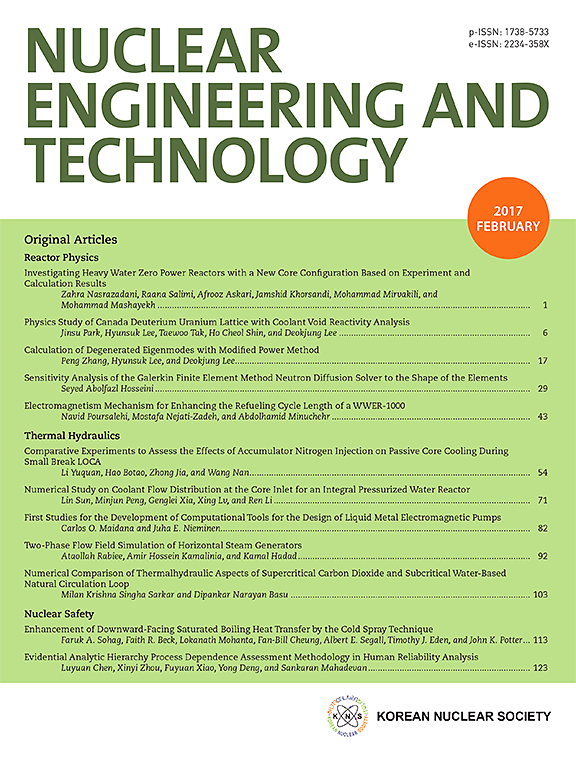Wolsung 核电厂 CANDU 乏燃料贮存罐的寿命热分析
IF 2.6
3区 工程技术
Q1 NUCLEAR SCIENCE & TECHNOLOGY
引用次数: 0
摘要
沃尔松厂址的 CANDU 乏燃料一直储存在干式储存系统中,如混凝土罐和模块化空气冷却储存系统。贮罐的主要作用是确保燃料在贮存期间的完整性,而这在很大程度上受到温度的影响。因此,对燃料罐的组件,特别是燃料包层进行热分析,对于证明其安全性至关重要。进行热分析主要是为了预测包壳的峰值温度(PCT),因为燃料的高温会促进氧化和裂解。随着贮存许可证到期日的临近,应准备将燃料转移到最终处置地点。这也需要进行热分析,以预测与脆性有关的最低包层温度(MCT)。因此,准确预测整个贮存期间的 PCT 和 MCT 至关重要。覆层温度主要受衰变热和环境条件的影响。寿命期内的 PCT 可能发生在贮存初期的夏季,而寿命期内的 MCT 则发生在贮存末期的冬季。在本研究中,我们使用一个现实的热分析模型计算了整个贮存期的 PCT 和 MCT,并随后进行了不确定性分析。本文章由计算机程序翻译,如有差异,请以英文原文为准。
Lifetime thermal analysis of the CANDU spent fuel storage canister at the Wolsung site
CANDU spent fuels in the Wolsung site have been stored in dry storage systems, such as concrete canisters and modular air-cooled storage system. The primary role of the canister is to ensure the integrity of the fuel during the storage period, which is significantly influenced by temperature. Thus, thermal analysis for the canister's components, especially for fuel cladding, is essential to demonstrate its safety. The thermal analysis has been conducted mainly for predicting the peak cladding temperature (PCT) since high temperature of the fuel can promote oxidation and cracking. As the expiration of storage license approaches, fuel transfer to final disposal should be prepared. This also requires a thermal analysis to predict minimum cladding temperature (MCT), which is related with brittleness. So, it is crucial to accurately predict both PCT and MCT during entire storage period. The cladding temperature is primarily influenced by decay heat and ambient conditions. The lifetime PCT may occur during summer at the beginning of storage, while the lifetime MCT occurs during winter at the end of storage. In this study, we calculated the PCT and MCT during the entire storage period using a realistic thermal analysis model and, subsequently, conducted their uncertainty analysis.
求助全文
通过发布文献求助,成功后即可免费获取论文全文。
去求助
来源期刊

Nuclear Engineering and Technology
工程技术-核科学技术
CiteScore
4.80
自引率
7.40%
发文量
431
审稿时长
3.5 months
期刊介绍:
Nuclear Engineering and Technology (NET), an international journal of the Korean Nuclear Society (KNS), publishes peer-reviewed papers on original research, ideas and developments in all areas of the field of nuclear science and technology. NET bimonthly publishes original articles, reviews, and technical notes. The journal is listed in the Science Citation Index Expanded (SCIE) of Thomson Reuters.
NET covers all fields for peaceful utilization of nuclear energy and radiation as follows:
1) Reactor Physics
2) Thermal Hydraulics
3) Nuclear Safety
4) Nuclear I&C
5) Nuclear Physics, Fusion, and Laser Technology
6) Nuclear Fuel Cycle and Radioactive Waste Management
7) Nuclear Fuel and Reactor Materials
8) Radiation Application
9) Radiation Protection
10) Nuclear Structural Analysis and Plant Management & Maintenance
11) Nuclear Policy, Economics, and Human Resource Development
 求助内容:
求助内容: 应助结果提醒方式:
应助结果提醒方式:


